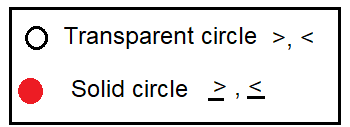GRAPHING THE INEQUALITY ON A NUMBER LINE
The relationship between two values that are not equal is defined by inequalities. Inequality means not equal. Generally, if two values are not equal, we use “not equal symbol (≠)”.
But to compare the values, whether it is less than or greater than, different inequalities are used. There are four inequalities signs are used.
|
< |
Less than |
x < 3 The values of x should be lesser than 3. |
|
> |
greater than |
x > 3 The values of x should be greater than 3. |
|
≤ |
Lesser than or equal |
x ≤ 3 The values of x should be lesser than or equal to 3. |
|
≥ |
greater than or equal |
x ≥ 3 The values of x should be greater than or equal to 3. |
Graphing inequality in number line

A compound inequality containing and is true only if both inequalities are true. Thus, the graph of a compound inequality containing and is the intersection of the graphs of the two inequalities.
In other words, the solution must be a solution of both inequalities.
That is, we have to shade the portion that we find in both graphs. If the particular region is not in one of the graphs, we should not shade the region.
Another type of compound inequality contains the word or. A compound inequality containing or is true if one or more of the inequalities is true. The graph of a compound inequality containing or is the of the graphs of the two inequalities.
In other words, the solution of the compound inequality is a solution of either inequality, not necessarily both. The union can be found by graphing each inequality.
Graph the inequality on a number line.
Problem 1 :
x ≤ -8
Solution :
Given, x ≤ -8
So, any real number less than or equal to -8 is a solution of the given equation.

The solution set of the given inequality is (-∞, -8].
Problem 2 :
x ≥ 6
Solution :
Given, x ≥ 6
So, any real number greater than or equal to 6 is a solution of the given equation.

The solution set of the given inequality is [6, ∞).
Problem 3 :
-3 ≤ x ≤ 5
Solution :
-3 ≤ x ≤ 5
Any real number which lies between -3 to 5 is solution.

The solution set of the given inequality is [-3, 5].
Problem 4 :
x ≥ -7 and x ≤ -1
Solution :
x ≥ -7 and x ≤ -1
Any real number greater than or equal to -7 and less than or equal to -1 is a solution.

The overlapping region is the solution. The solution set of the given inequality is
[-7, -1]
Problem 5 :
x ≥ -2 or x ≤ 4
Solution :
Given, x ≥ -2 or x ≤ 4
Any real number greater than or equal to -2 and less than or equal to 4 is a solution of the given equation.

The solution set of the given inequality is (-∞, 4].
Problem 6 :
│x│≥ 0
Solution :
Given, │x│≥ 0
So, any real number greater than or equal to 0 is a solution of the given equation.
Problem 7 :
A subway ride for a student costs $1.25. A monthly pass costs $35.
a. Write an inequality that represents the number of times you must ride the subway for the monthly pass to be a better deal.
b. You ride the subway about 45 times per month. Should you buy the monthly pass? Explain.
Solution :
a)
Let x be the number of of rides
1.25x
Monthly costs = $35
35 < 1.25x
35/1.25 < x
28 < x
b)
Number of times rides = 45
= 1.25(45)
= 56.25
56.25 > 35
Which is more than monthly pass. Then, you should buy montly pass.
Problem 8 :
Consider the inequality b > − 2.
a. Describe the values of b that are solutions of the inequality.
b. Describe the values of b that are not solutions of the inequality. Write an inequality for these values.
Solution :
a) The values of b are which are greater than -2.
b) The values of b that are lesser than -2
Problem 9 :
A person can be no taller than 6.25 feet to become an astronaut pilot for NASA. Your friend is 5 feet 9 inches tall. Write and solve an inequality that represents how much your friend can grow and still meet the requirement.
Solution :
1 feet = 12 inches
1 inch = 1/12 feet
9 inches = 9/12
= 3/4 feet
= 0.75 feet
5 feet 9 inches = 5 + 0.75
= 5.75 feet
Let x be the height to be added to inorder to meet out hte requirement.
5.75 + x ≤ 6.25
x ≤ 6.25 - 5.75
x ≤ 0.5
So, your friend can grow no more than 0.5 foot, or 6 inches.
Problem 10 :
A small airplane can hold 44 passengers. Fifteen passengers board the plane.
a. Write and solve an inequality that represents the additional number of passengers that can board the plane.
b. Can 30 more passengers board the plane? Explain.
a) Number of passesngers board the plane = x
x + 15 < 44
x < 44 - 15
x < 29
b) Lesser than 29 passengers alone can board. Then, 30 more passengers cannot board the plane.
Recent Articles
-
Finding Range of Values Inequality Problems
May 21, 24 08:51 PM
Finding Range of Values Inequality Problems -
Solving Two Step Inequality Word Problems
May 21, 24 08:51 AM
Solving Two Step Inequality Word Problems -
Exponential Function Context and Data Modeling
May 20, 24 10:45 PM
Exponential Function Context and Data Modeling